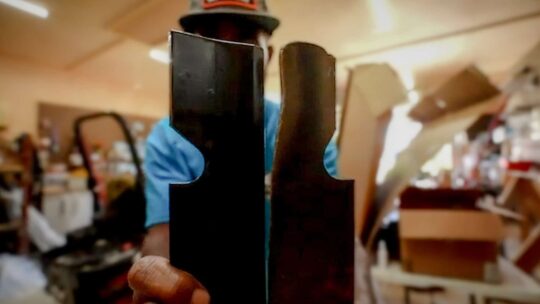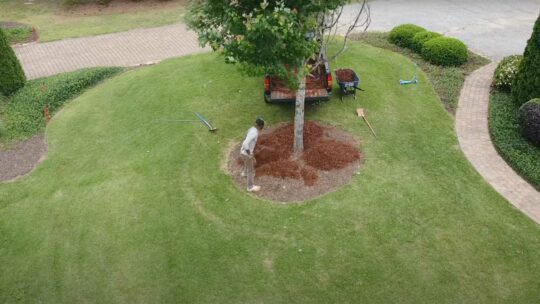No matter what kind of lawn you have, it’s important to know how to control weeds in your lawn. Thankfully, there are practices that everyone can do—no matter if you have a green thumb or not.
In this Backyard Life video, pro angler Brian Latimer shares his tips to keep your lawn weed-free. And, he should know. Because, before becoming a pro angler, Latimer helped run his family’s landscaping business. He says it’s actually a lot easier to manage weeds than most people might think. Here’s a rundown of his top seven tips.
Select the Right Grass Type
To start, creating a weed-free lawn begins with understanding what grass species is best suited for your area. Latimer lives in the Southeast, as such, not every grass type is able to thrive in these unique conditions. That’s why his lawn is planted with warm-season Palisades Zoysia—it grows best June through late September, then slows in the fall before going dormant in the winter. It’s the perfect grass type, because it requires less watering and mowing in the fall and winter when he’s on the road fishing.
Latimer’s property doesn’t have many trees, so his lawn’s exposed to full sun and high temperatures. That’s okay, though, since the warm-season Zoysia is incredibly heat- and drought-tolerant. Although he has an irrigation system, he only uses it to get his lawn by until the next rain cycle. And, since his lawn can withstand the drier times of the year, he doesn’t have many problems with it thinning out and drying.
Moisture Management
Whether it’s a dry or wet year, different weed types will inevitably try to take over. Basically, Latimer says, it’s hard to avoid weeds no matter the weather or season. Regardless, one of the most important things that’ll help keep them at bay is maintaining the right lawn moisture content. A lawn that’s too wet will create a prime habitat for weed seeds to germinate in. But, if you maintain proper lawn moisture, it will grow healthier—and more weed-free.
It’s hard to say exactly how much water a particular lawn needs. Basically, you don’t want to water too much, or too little. Ultimately, the amount of water your lawn will require depends on your specific soil type. Latimer notes that he never sets a timer on his irrigation system—he only waters when he can tell his lawn clearly needs it. (For instance, he waters when little hot spots become visible or it seems like the lawn’s growth is stalling.) Despite a watering rule of thumb that’s sometimes perceived as too on-the-nose, Latimer maintains that, “the best time to water your lawn is when it’s dry.”
Strive for a Thick Canopy
Maintaining a thick canopy is another critical component in creating a healthy, weed-free lawn. Doing so makes it hard for weed seeds to find their way into the soil to germinate. However, when it’s dry out, canopies will often shrink—or desiccate. This canopy reduction will enable weed seeds from neighboring yards from reaching and germinating in your lawn’s soil. So, selecting the right canopy for your yard will help decrease lawn desiccation.
Use Fertilizer
Committing to a regular fertilization regiment will also aid in lawn growth and health. By fertilizing, you’re supporting a healthy, tall lawn that creates a nice canopy. Fertilizer also helps balance soil pH balance, which leads to fewer lawn and yard weeds.
Pay Attention to Mowing Height
Knowing the proper height to mow your grass will promote a healthier lawn. Particularly, warm-season grasses that tend to harbor weeds during the spring when they’re not yet actively growing. Mowing at the correct height will help create a thick grass canopy that deters weed seed germination.
Chemical Application
At some point, Latimer says you’ll probably have to apply some type of chemicals to promote lawn growth and prevent or eradicate weeds. If you’re uncomfortable doing it yourself, Latimer recommends hiring a professional. But, if you’re comfortable with spraying equipment and calculating the square footage that needs to be treated, he says, “go for it!” Latimer offers a very general tip where warm-season grass is concerned: make sure to apply pre-emergent herbicides during the spring.
There are two key grass transitions, explains Latimer. The first is when it’s transforming from dormancy to spring green-up. The other is when growth is slowing to a standstill. Those are the most important times to fertilize and apply pre-emergents. Doing this will keep weed seeds from germinating and growing when your lawn isn’t. There are many months when your grass is dormant, so Latimer says you definitely want to apply herbicides to keep weeds from taking over. But, he cautions, you won’t see the results until three to four months later. Therefore, it’s important to do so in the fall and spring so you’ll see results at the right times of the year.
Clean Your Equipment
Finally, don’t forget to clean your equipment. There’s a part of Latimer’s backyard he calls, “a jungle yard.” It’s where he and his sons ride dirt bikes and have all sorts of other backyard fun. But, it’s also home to a lot of weed seeds that come into contact with the same mower his front lawn’s maintained with. As a result, “jungle yard” weed seeds could potentially be transported from Latimer’s mower deck to his manicured Palisades Zoysia. So, always be sure and clean your equipment, Latimer says. Just wash your deck, tires, and wheel wells off periodically. Even blowing your mower off with a leaf blower will drastically reduce the amount of weed seeds you’ll have in your yard. Simply put, clean equipment makes a world of difference.



